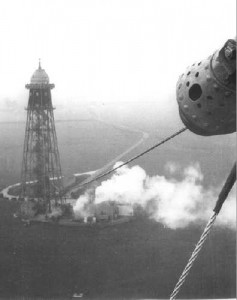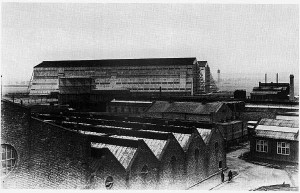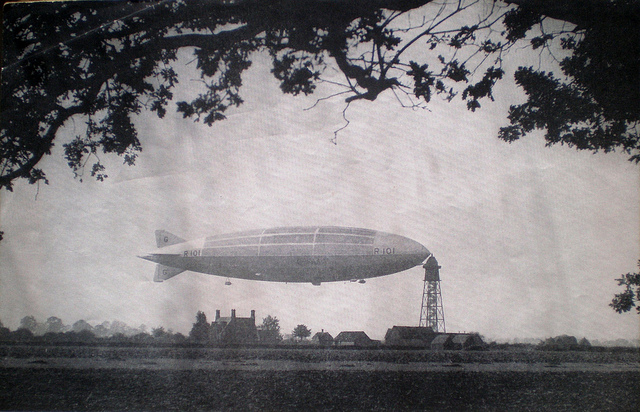
The destruction of the airship R101 on its maiden flight on 5 October 1930 ended British dreams of linking the empire with a fleet of luxury hotels in the clouds. It ended something else, too: it ended Bedfordshire.

I grew up with the great airship hangars at Cardington visible from my bedroom window, and the son of the vicar of Cardington was my friend. You’d cycle down through a flat landscape of fields and cow parsley, crossing and recrossing the empty trackbed of the Midland branch to Hitchin that had served until Beeching, until you’d reach the church with its great memorial to the dead of the crash outside. Inside hung the scorched banners they’d rescued from the airship’s wreckage.
Over all of this hung the same stillness and silence and sense of curtailment you find around the war memorials in Oxford colleges.
Of course, both my friend and I had made the schoolboy error of reading John G. Fuller’s book The Airmen Who Would Not Die. This sleep-destroying text told the story of how medium Eileen Garrett received warnings from the dead about R101 before the crash – and how she made contact with the crash’s victims afterwards. During a séance that had intended to invoke the spirit of Arthur Conan Doyle, a voice claiming to be R101 Flight Lieutenant H. Carmichael Irwin came through, and said:
I must do something about it… The whole bulk of the dirigible was entirely and absolutely too much for her engine’s capacity. Engines too heavy. It was this that made me on five occasions have to scuttle to safety. Useful lift too small. Gross lift computed badly — inform control panel. And this idea of new elevators totally mad. Elevator jammed. Oil pipe plugged … Flying too low altitude and never could rise. Disposable lift could not be utilized. Load too great for long flight… Cruising speed bad and ship badly swinging. Severe tension on the fabric, which is chafing… Engines wrong – too heavy — cannot rise. Never reached cruising altitude – same in trials. Too short trials. No one knew the ship properly. Weather bad for long flight. Fabric all waterlogged and ship’s nose is down. Impossible to rise. Cannot trim. Almost scraped the roofs of Achy. Kept to railway. An inquiry to be held later it will be found that the superstructure of the envelope contained no resilience and had far too much weight in envelope. The added middle section was entirely wrong… too heavy, too much over weighted for the capacity of the engines…
Further seances enabled “Carmichael†to add detail, on one occasion in the presence of Major Oliver Villiers of the Ministry of Civil Aviation. Since Garrett’s day, seances have been held in the great Cardington sheds themselves. These, to my and my friend’s mutual upset, were darker, nastier occasions. Yes, the crash victims lingered there: no, they had nothing to say to the living – save to demand that they be left alone, in aggressive, threatening tones.
Halfway through writing this, I had to get up and turn on the television. Still spooked after all these years. Even without the paranormal aspect to it, the accident has a lingering ability to upset: it’s hard to endure this witness’s testimony to the end –
Â

That interview is quite a find.
Do you know Nevil Shute’s “Slide Rule”? It’s a fascinating account of his years as an aeronautical engineer in the airship business.
I didn’t – thankyou!